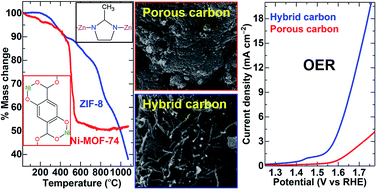当前位置:
X-MOL 学术
›
J. Mater. Chem. A
›
论文详情
Our official English website, www.x-mol.net, welcomes your
feedback! (Note: you will need to create a separate account there.)
Graphitic nanostructures in a porous carbon framework significantly enhance electrocatalytic oxygen evolution
Journal of Materials Chemistry A ( IF 10.7 ) Pub Date : 2017-11-06 00:00:00 , DOI: 10.1039/c7ta03027d Srinivas Gadipelli 1, 2, 3, 4 , Zhuangnan Li 1, 2, 3, 4 , Tingting Zhao 1, 2, 3, 4 , Yuchen Yang 1, 2, 3, 4 , Taner Yildirim 5, 6, 7, 8 , Zhengxiao Guo 1, 2, 3, 4
Journal of Materials Chemistry A ( IF 10.7 ) Pub Date : 2017-11-06 00:00:00 , DOI: 10.1039/c7ta03027d Srinivas Gadipelli 1, 2, 3, 4 , Zhuangnan Li 1, 2, 3, 4 , Tingting Zhao 1, 2, 3, 4 , Yuchen Yang 1, 2, 3, 4 , Taner Yildirim 5, 6, 7, 8 , Zhengxiao Guo 1, 2, 3, 4
Affiliation

|
A hybrid structure, a graphitic nanostructures@porous carbon framework, is developed by utilizing the bimetallic zeolitic imidazolate framework-8 (ZIF-8) as a solid precursor, simultaneously templating porous carbon and growing graphitic nanocarbon in a simplified chemical vapor deposition (CVD) fashion. A ligand, 2-methylimidazolate (2MIM), in the ZIF-8 decomposes above 600 °C to yield active carbon/hydrocarbon radicals/vapour. With the idea of using the high catalytic activity of nickel to grow graphitic nanostructures in a CVD process from gaseous carbon feedstocks, a precursor, bimetallic ZIF-8, is synthesized by partial substitution of zinc metal centres by nickel. Such nickel centres thus act as nanocatalysts to grow graphitic nanostructures from the carbon radicals arising from the partly decomposed ligand of the framework during the carbonization step. These hybrid structures show a highly enhanced electrocatalytic activity for the water splitting oxygen evolution reaction (OER). Furthermore the catalytic activity for the oxygen reduction and hydrogen evolution reactions (ORR and HER), and gas uptake capacities for H2 and CO2 are enhanced with respect to the increased porosity and nitrogen doping in the samples. We also show that not all the MOF-based precursors with nickel metal centres are suitable for producing nanographitic structures. Our further investigation suggests that the graphitization in the samples plays a critical role in enhancing the catalytic activities.
中文翻译:

多孔碳骨架中的石墨纳米结构显着增强了电催化氧的释放
通过使用双金属咪唑骨架8(ZIF-8)作为固体前体,同时模板化多孔碳并以简化的化学气相沉积(CVD)方式生长石墨纳米碳,开发了一种杂化结构,即石墨纳米结构@多孔碳骨架。时尚。ZIF-8中的一个配体2-甲基咪唑酸酯(2MIM)在600°C以上分解,产生活性碳/烃基/蒸气。在使用CVD的过程中,从气态碳原料中利用镍的高催化活性来生长石墨纳米结构的想法,通过用镍部分取代锌金属中心来合成前体双金属ZIF-8。这样的镍中心因此充当纳米催化剂,以从碳化步骤期间由骨架的部分分解的配体产生的碳自由基生长石墨纳米结构。这些杂化结构对水分解氧放出反应(OER)表现出高度增强的电催化活性。此外,氧气还原和氢气生成反应(ORR和HER)的催化活性以及H的气体吸收能力关于样品中增加的孔隙率和氮掺杂,提高了2和CO 2的含量。我们还表明,并非所有具有镍金属中心的基于MOF的前体都适合生产纳米石墨结构。我们的进一步研究表明,样品中的石墨化在增强催化活性方面起着至关重要的作用。
更新日期:2017-11-17
中文翻译:

多孔碳骨架中的石墨纳米结构显着增强了电催化氧的释放
通过使用双金属咪唑骨架8(ZIF-8)作为固体前体,同时模板化多孔碳并以简化的化学气相沉积(CVD)方式生长石墨纳米碳,开发了一种杂化结构,即石墨纳米结构@多孔碳骨架。时尚。ZIF-8中的一个配体2-甲基咪唑酸酯(2MIM)在600°C以上分解,产生活性碳/烃基/蒸气。在使用CVD的过程中,从气态碳原料中利用镍的高催化活性来生长石墨纳米结构的想法,通过用镍部分取代锌金属中心来合成前体双金属ZIF-8。这样的镍中心因此充当纳米催化剂,以从碳化步骤期间由骨架的部分分解的配体产生的碳自由基生长石墨纳米结构。这些杂化结构对水分解氧放出反应(OER)表现出高度增强的电催化活性。此外,氧气还原和氢气生成反应(ORR和HER)的催化活性以及H的气体吸收能力关于样品中增加的孔隙率和氮掺杂,提高了2和CO 2的含量。我们还表明,并非所有具有镍金属中心的基于MOF的前体都适合生产纳米石墨结构。我们的进一步研究表明,样品中的石墨化在增强催化活性方面起着至关重要的作用。











































 京公网安备 11010802027423号
京公网安备 11010802027423号